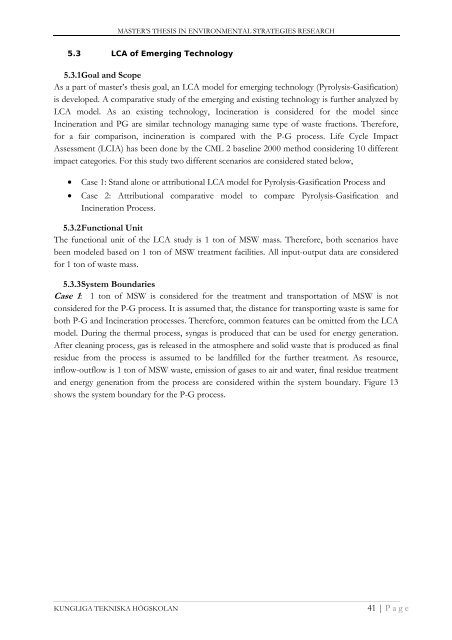Technical Development of Waste Sector in Sweden: Survey
Technical Development of Waste Sector in Sweden: Survey
Technical Development of Waste Sector in Sweden: Survey
Create successful ePaper yourself
Turn your PDF publications into a flip-book with our unique Google optimized e-Paper software.
MASTER’S THESIS IN ENVIRONMENTAL STRATEGIES RESEARCH<br />
5.3 LCA <strong>of</strong> Emerg<strong>in</strong>g Technology<br />
5.3.1 Goal and Scope<br />
As a part <strong>of</strong> master’s thesis goal, an LCA model for emerg<strong>in</strong>g technology (Pyrolysis-Gasification)<br />
is developed. A comparative study <strong>of</strong> the emerg<strong>in</strong>g and exist<strong>in</strong>g technology is further analyzed by<br />
LCA model. As an exist<strong>in</strong>g technology, Inc<strong>in</strong>eration is considered for the model s<strong>in</strong>ce<br />
Inc<strong>in</strong>eration and PG are similar technology manag<strong>in</strong>g same type <strong>of</strong> waste fractions. Therefore,<br />
for a fair comparison, <strong>in</strong>c<strong>in</strong>eration is compared with the P-G process. Life Cycle Impact<br />
Assessment (LCIA) has been done by the CML 2 basel<strong>in</strong>e 2000 method consider<strong>in</strong>g 10 different<br />
impact categories. For this study two different scenarios are considered stated below,<br />
• Case 1: Stand alone or attributional LCA model for Pyrolysis-Gasification Process and<br />
• Case 2: Attributional comparative model to compare Pyrolysis-Gasification and<br />
Inc<strong>in</strong>eration Process.<br />
5.3.2 Functional Unit<br />
The functional unit <strong>of</strong> the LCA study is 1 ton <strong>of</strong> MSW mass. Therefore, both scenarios have<br />
been modeled based on 1 ton <strong>of</strong> MSW treatment facilities. All <strong>in</strong>put-output data are considered<br />
for 1 ton <strong>of</strong> waste mass.<br />
5.3.3 System Boundaries<br />
Case 1: 1 ton <strong>of</strong> MSW is considered for the treatment and transportation <strong>of</strong> MSW is not<br />
considered for the P-G process. It is assumed that, the distance for transport<strong>in</strong>g waste is same for<br />
both P-G and Inc<strong>in</strong>eration processes. Therefore, common features can be omitted from the LCA<br />
model. Dur<strong>in</strong>g the thermal process, syngas is produced that can be used for energy generation.<br />
After clean<strong>in</strong>g process, gas is released <strong>in</strong> the atmosphere and solid waste that is produced as f<strong>in</strong>al<br />
residue from the process is assumed to be landfilled for the further treatment. As resource,<br />
<strong>in</strong>flow-outflow is 1 ton <strong>of</strong> MSW waste, emission <strong>of</strong> gases to air and water, f<strong>in</strong>al residue treatment<br />
and energy generation from the process are considered with<strong>in</strong> the system boundary. Figure 13<br />
shows the system boundary for the P-G process.<br />
KUNGLIGA TEKNISKA HÖGSKOLAN<br />
41 | Page
















